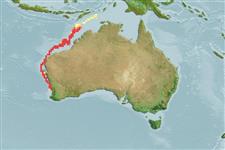Élasmobranches (requins et raies) (sharks and rays) >
Torpediniformes (Electric rays) >
Narcinidae (Numbfishes)
Etymology: lasti: Named for Dr. Peter R. Last, in recognition of his studies in the taxonomy and distribution of Australian elasmobranchs..
Environment: milieu / climate zone / depth range / distribution range
Écologie
marin démersal; profondeur 178 - 350 m (Ref. 75154). Tropical; 8°S - 32°S, 111°E - 132°E (Ref. 114953)
Eastern Indian Ocean: Australia (Western Australia to off the Northern Territory) and Arafura Sea (SE Indonesia, south of Tanimbar I.).
Taille / Poids / Âge
Maturity: Lm ? range ? - 24 cm
Max length : 36.5 cm TL mâle / non sexé; (Ref. 93928)
Description synthétique
Clés d'identification | Morphologie | Morphométrie
This species is distinguished by the following characters: tail length as measured from cloaca much longer than disc width or length (means: tail length 53.7% of TL, vs. disc width 40.3% of TL and disc length 42.1% TL); nasal curtain much wider than long; colour pattern dorsally uniform light yellowish-brown, which is also present over preorbital snout region, no distinctive spotting or markings over disc and tail; low and inconspicuous lateral tail ridge, not resembling a distinct fold; mean preorbital snout length just over 10% of TL (Ref. 93928).
Usually found over sandy and muddy bottoms (Ref. 93928). Maturity size reaches at ca. 24 cm TL; born at ca. 7-8 cm TL. Biology little known (Ref. 114953).
Life cycle and mating behavior
Maturities | Reproduction | Spawnings | Egg(s) | Fecundities | Larves
de Carvalho, M.R. and B. Séret, 2002. Narcine lasti: a new species of numbfish from Western Australia and Indonesia (Chondrichthyes: Torpediniformes: Narcinidae). Rec. Western Australia Mus. 20:393-408. (Ref. 93928)
Statut dans la liste rouge de l'IUCN (Ref. 130435)
Menace pour l'homme
Harmless
Utilisations par l'homme
Outils
Articles particuliers
Télécharger en XML
Sources Internet
Estimates based on models
Preferred temperature (Ref.
123201): 13.2 - 17.5, mean 15.6 °C (based on 19 cells).
Phylogenetic diversity index (Ref.
82804): PD
50 = 0.5312 [Uniqueness, from 0.5 = low to 2.0 = high].
Bayesian length-weight: a=0.01175 (0.00476 - 0.02897), b=2.88 (2.66 - 3.10), in cm total length, based on LWR estimates for this (Sub)family-body shape (Ref.
93245).
Niveau trophique (Ref.
69278): 3.3 ±0.4 se; based on size and trophs of closest relatives
Résilience (Ref.
120179): Faible, temps minimum de doublement de population : 4,5 à 14 années (Assuming fecundity<100).
Fishing Vulnerability (Ref.
59153): Low to moderate vulnerability (27 of 100).
